Product Hub May 25, 2015
The Next Generation
New wearable devices for infants and kids promise to change the future of child care – and make this the most wired (or wireless) generation yet.
It’s a milestone day when a young couple takes their newborn on his or her first long trip. In addition to gathering and packing all the necessary accoutrements – an endless supply of diapers, wipes, onesies, bottles, pacifiers and so much more – most parents carry a hefty amount of anxiety. How will they face their infant’s less-than-composed moments along the way?
But what if the persistent crying and agitation is more than just a reaction to an unfamiliar environment? Indeed, what if the child is actually becoming sick, and doesn’t exhibit symptoms, such as endless crying, even vomiting or a fever, until three-quarters of the way to the destination?
That’s where wearable tech for kids comes in. Pixie Scientific has created the Smart Diaper with a scannable QR code on the front that lets parents track constant changes in their child’s health. It provides unobtrusive monitoring, so that the baby’s comfort is never disrupted. “It will provide information each time you scan, but it only sends an alert to the smartphone when something is amiss,” says Pixie Scientific Co-Founder Jennie Rubinshteyn. “In the future, we’d like physicians to be able to receive the data and give immediate advice from a distance. This is baby health monitoring for the 21st century.”
Likewise, wearable technology is set to revolutionize all manners of child care, from health and well-being to geolocating and tracking daily activities. A future where no child goes lost or parents don’t have to guess about their baby’s health? It’s closer than you think.
“This is baby health monitoring for the 21st century.”
Jennie Rubinshteyn, Pixie Scientific
Smart Diapers
Background: Pixie Scientific co-founders Jennie Rubinshteyn and her husband Yaroslav Faybishenko were driving their two young children home to New York City from a trip to Vermont. Usually a six-hour drive, it became a 10-hour slog with all the stops to change and feed. “My husband and I realized that if one of the kids had been getting sick on the way up, we wouldn’t have known and then we would have spent our entire vacation at the doctor’s,” says Rubinshteyn. “We also realized that a full diaper was also full of data.”
Innerworkings: Smart Diapers feature a non-toxic panel in the front of each diaper that contains dry reagents, the same found in dipsticks that change color based on the makeup of the child’s body fluids. Parents use the Smart Diapers mobile app to scan the QR code on the front of the diaper and analyze the makeup of the urine.

Smart Diapers from Pixie Scientific (circle 84 on Free Info Card) feature a reactive agent panel that can be scanned with a smartphone to track developing health conditions.
Material: Besides the panel and QR code, the chemical-free diapers are no different than standard high-quality diapers. The panel never comes in contact with the child.
Breakthrough: The messy process of baby urine, dipsticks and cotton balls are replaced with Pixie Scientific’s smartphone app, which will be able to tell parents when an infection is looming. “Normally, parents have to wait for symptoms to present themselves,” Rubinshteyn explains. “With the Smart Diaper, data can be analyzed over time before conditions become worse.” The scans take fewer than 10 seconds and according to Rubinshteyn, can track changes in health and nutrition, including vitamin deficiencies, hydration levels, nutrition and infections such as a UTI. Serious conditions such as kidney problems or Type 1 diabetes can be detected in the very early stages.
Release: Pixie Scientific’s Smart Diapers are still in the trial phase and awaiting official approval from the FDA.
Sproutling
Background: Entrepreneur Chris Bruce has two daughters. “My first daughter was difficult to get to sleep,” explains the founder and CEO of Sproutling. “My second daughter slept like a lump of coal. So establishing individual waking and sleeping patterns was something personal for me.” He remembers back to when his youngest daughter, she of sound sleep and predictable waking patterns, would wake up every night at 10 p.m. without fail. But one night, 11 o’clock came and went, and she hadn’t woken. “We were a little concerned, and the grainy monitor wasn’t helpful,” says Bruce. “So I went to check on her, trying not to wake her up. She was fine, but we realized they have to be monitored constantly.” He knew there had to be a better way to monitor his young children while they slept.
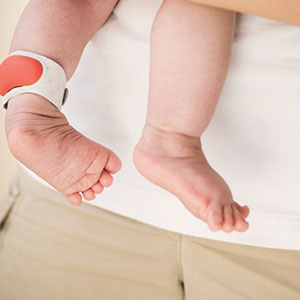
The Sproutling (circle 85 on Free Info Card) ankle monitor gathers data on a baby’s vital signs and the surrounding environment, and sends easy-to-analyze information to parents’ smartphones.
Innerworkings: Sproutling is an ankle monitoring device with a sensor that measures vital signs during sleep, such as heartbeat, temperature and respiration, as well as positioning and movement, and also environmental factors (like temperature, humidity and noise levels) that can affect sleep. It also senses how the baby is sleeping, either restfully or fitfully, and the mood in which he or she awakens. “It gathers 100 measurements of data a minute, all of which can potentially become insights,” says Bruce. “It can tell you when the baby will wake up, or if an increase or decrease in temperature will let them sleep longer. It becomes customized to that child.” Bluetooth technology links the sensor to an app on the parents’ smartphones, which then provides updates. More than one child’s information can be displayed, and temporary access can even be granted to a babysitter.
“Sproutling can tell you when the baby will wake up, or if an increase or decrease in temperature will let them sleep longer. It becomes customized to that child. ”
Chris Bruce, Sproutling
Material: The device uses medical-grade hypoallergenic components with no toxic chemicals. “We just always assumed it would end up in the mouth,” Bruce explains. “We had it tested at a consumer product testing lab and made certain that it met all safety standards for toys with small parts.”
Breakthrough: Bruce says Sproutling doesn’t “bombard parents” with data or offers arbitrary standards for all babies. “If it’s just random information that doesn’t say what or why, if there’s no context, that can cause more anxiety,” he says. “It tells you what current conditions are like and gives suggestions.”
Release: Winner of a Best of Innovation Award at CES, Sproutling will start shipping preview orders this summer at $299 for each sensor. As of this writing, early beta testers were already putting it into use, and the company has plans to work with larger brands to study how certain foods affect sleep. “It will definitely change how we study sleep habits. The last study only looked at 1,079 babies over three nights. With Sproutling, we can potentially study millions of babies. It really ups your parenting IQ.”
Tinitell
Background: Mats Horn, the Stockholm-based founder and CEO of Tinitell, was visiting a friend with a young son. When the boy wanted to go outside to play, there was no easy way for him to communicate with his father about where he was going. Instead, he sat inside and played on an iPad. “I thought that was sad,” says Horn. “When I was young, I was outside all the time and we used walkie talkies. I decided to bring that communication technology to a wearable device.”
Innerworkings: Tinitell is a wristphone that allows parents to track their children’s whereabouts via GPS and mobile service. The 2G unlocked mobile phone can be used with different GSM SIM cards (depending on the area where it’s used), and isn’t locked into one service carrier’s network. It includes voice recognition technology for activating calls, as well as a built-in GPS/Glonass system for tracking. A smartphone app, which can display information from several Tinitells simultaneously, allows parents to communicate with and track the wearer.
Material: Because Tinitell is meant to accompany kids throughout the rough-and-tumble nature of their daily activities, its construction was of utmost importance. Each of the devices is made of medical-grade silicone plastic, and is water-, dirt- and sand-resistant.

Tinitell (circle 86 on Free Info Card) allows kids to make calls and can be tracked by parents via a built-in GPS system.
Breakthrough: “Parents can see that their child has arrived via the GPS, which communicates with the app,” says Horn. “They can monitor their location if they move and can call them. It’s added peace of mind. It’s also perfect for traveling. As long as you have a SIM card for the area you travel to, you can keep track of the child that way. It can work anywhere in the world.”
Release: Parents can pre-order Tinitell at $149 per device, in time for the official wide-release launch this summer.
Child Angel
Background: Child Angel was recently honored as one of the top devices at the UK Gadget Show – elation for inventor Andrew Purcell that was a far cry from how he felt when his two-year-old son went missing in a shopping center a few years back. He has one word to describe the experience: “Horrible.” In an instant, his son simply wasn’t there. Purcell and his wife kept calm, reassuring one another as they walked one loop around the center, thinking he was close by. When they were unsuccessful, they tried a second loop as their concern mounted exponentially with every passing second. The littlest Purcell was found unharmed, and Andrew Purcell had discovered his new mission: To make sure fewer and fewer parents had a similar heart-sinking feeling of dread.
“Parents can monitor their children’s location if they move and can call them. It’s added peace of mind.”
Mats Horn, Tinitell
Innerworkings: Child Angel is a locator device for children’s wrists. It uses a combination of GPS, Wi-Fi and GSM technology to communicate with the Child Angel app on parents’ smartphones to track kids’ locations. It also features interchangeable face plates with characters from popular culture that will be familiar to the child wearers. “We wanted to make sure they loved to wear it,” says Purcell, founder and CEO of UK-based Child Angel Ltd. “We also asked [kids] what they wanted the device to do in case they got lost. They said, ‘Can we just undo it?’ So that’s how we designed it. If the child can’t see Mommy or Daddy, they undo the device and it sends an instant alert to parents’ smartphones with their exact location.”
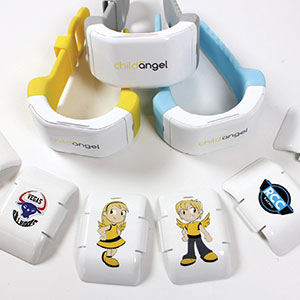
Child Angel (circle 87 on Free Info Card) wrist devices combine GPS, Wi-Fi and GSM technologies to provide unparalleled tracking abilities for parents.
Material: The device is made of soft silicone, ideal for small wrists, and features a durable construction. “It’s chunky and robust, and very secure, though it’s easy to take off if necessary,” explains Purcell, who adds that Child Angel has met product testing standards in the U.S. and UK. “Kids can bash it around and throw it about without damaging it.”
“We didn’t want them to feel imprisoned by wearable technology.”
Nicolas Bruneau, Enerban
Breakthrough: Child Angel also offers Geo Fencing technology, which allows parents to set physical boundaries for the device beyond a typical circular tracking field. “You can set the exact shape of the boundary,” says Purcell, “and if the child moves beyond what you’ve set, it sends an alert.”
Release: Available for pre-order currently, Child Angel will be available to consumers late in 2015 or early 2016. Parents can expect to pay around $149 for one device, along with a monthly fee of about $8 to $10. Purcell says the company will team-up with major brands in the future for different applications, such as large groups of school students and pet tracking.
“It’s chunky and robust, and very secure, though it’s easy to take off if necessary.”
Andrew Purcell, Child Angel
Miiya
Background: Kids’ health is especially important for Nicolas and Frédéric Bruneau, co-founders of Enerban. As a parent and a diabetic, a condition that runs in his family, Nicolas Bruneau knows that physical activity is necessary to maintain good health, and that healthy habits must be instilled early. So he and his brother set out to create a wrist device for kids that encourages daily exercise. “The World Health Organization recommends that children get one hour of physical activity every day, so we wanted to help them achieve that and grow up healthier in general,” Bruneau explains. “That’s why we developed the Miiya device.”
Innerworkings: Each device, designed for kids ages four through 10, contains an embedded inertial measurement unit that detects kids’ movements, whatever it may entail during the day. “Adult activity is different from kids’ activity,” says Bruneau. “Kids move their arms and legs more and even walk on all fours. Miiya can also detect skateboarding, running and biking.” The Miiya character on the device’s screen (similar to the popular Tamagotchi characters popular in Japan and the U.S.) encourages kids to exercise by starting out big and fluffy and becoming smaller and thinner with more activity. “For a kid, it’s hard to understand a figure like ‘10,000 steps’ when they can barely count to 20,” says Bruneau. Kids receive gold stars in their Miiya profiles, and if their Miiya reaches Superhero status at the end of the day, the child is given additional physical tasks to fulfill.
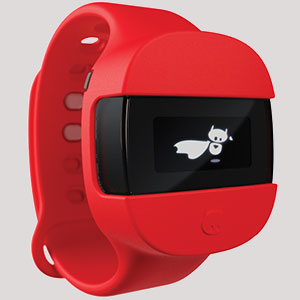
Miiya from Enerban (circle 88 on Free Info Card) measures kids’ activity during the day and encourages them to stay active.
Material: It’s made of soft, smooth silicone that’s comfortable on small wrists and keeps electronic components secure. It’s also impact-resistant and sand-proof.
No Easy Answers
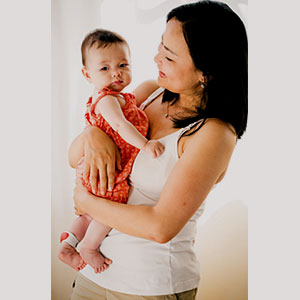
One of the most frightening things that new parents are warned about when taking their child home from the hospital for the first time is Sudden Infant Death Syndrome, or SIDS. Each year, according to the CDC, as many as 4,000 American children between one month and one year old, seemingly healthy and showing no signs of distress when put to bed, never wake up. SIDS is insidious, striking without warning, and often unexplainable, even after a thorough investigation. Most disconcertingly, no guaranteed preventive measure has yet been discovered. Parents can limit their baby’s risk by always putting their baby to sleep on his or her back, making sure the sleeping surface is firm, and keeping soft objects and loose bedding out of the crib.
With new wearable devices such as Sproutling that are promising a whole new way to monitor babies’ vital signs, it would seem as though a definitive answer to SIDS is on the horizon. But product developers urge parents not to rely on wearable tech as the new preventative measure for SIDS, at least not yet.
“The FDA has not approved any device that will prevent SIDS,” says Chris Bruce, the founder and CEO of Sproutling. “What we can say is that with Sproutling, parents have access to alerts, such as heart rate levels and body position changes. It gives access to an unprecedented amount of data, and we’ll be able to study even more babies’ vital signs and sleeping patterns to help parents provide better care for their children.”
Breakthrough:The Miiya can also be synchronized with Bluetooth so kids can voluntarily let parents know what kinds of activity they did that day via a smartphone app. Often when parents ask what they’ve been up to, says Bruneau, kids are a bit secretive. But allowing them to choose voluntarily to share their daily activity could prove a more attractive means of opening up.
Release: Miiya will be officially launch this summer, starting in the company’s e-commerce store at $99 per device. The device does also offer location tracking that warns parents if the child leaves a specific area but doesn’t say exactly where they are. “We wanted to give kids a little bit of independence, so they can also choose to tag their location to let their parents know where they’ve been,” Bruneau says. “We didn’t want them to feel imprisoned by it. We want them to love to wear it.”
Sara Lavenduski is an assistant editor for Wearables. Contact her at slavenduski@asicentral.com and follow her on Twitter at @SaraLav_ASI.
Not Just for Kids
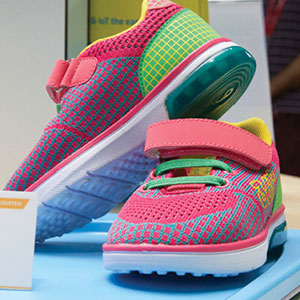
MediaTek, headquartered in Silicon Valley, CA, is a world leader in chip technology for a myriad of applications, including TVs, handheld devices, Kindles and, of course, wearable technology. Currently the company is working on the kids’ MediaTek 361 Smart Shoe that contains a GPS tracking chip. “In China, there are so many kidnappings,” says Michael Reidbord, head of wearable technology for MediaTek. “This shoe allows parents to track their child at all times on their mobile phone. They can also set parameters and an alarm will go off if the child moves beyond those parameters.”
But it’s not just kids who can benefit from tracking technology. It could also be valuable for a patient with Alzheimer’s who has a tendency to wander. A sensor that analyzes rapid vertical movement can be used to track falls of both children and the elderly. Or perhaps glucose level sensors can benefit diabetes sufferers. Athletes’ smart apparel tracks vital signs and hydration levels, and firefighter suits will soon sense heat and gas levels; when it reaches a certain threshold, says Reidbord, an alert will go out to the team’s commander, letting him or her know that the firefighters are in a dangerous situation.
Reidbord believes wearable technology will really gain momentum when it consistently offers functionality that truly meets a need. “A light-up bracelet on a catwalk doesn’t add real value,” he explains. “But if it saves lives, people will pick that up.”

Product Hub
Find the latest in quality products, must-know trends and fresh ideas for upcoming end-buyer campaigns.
